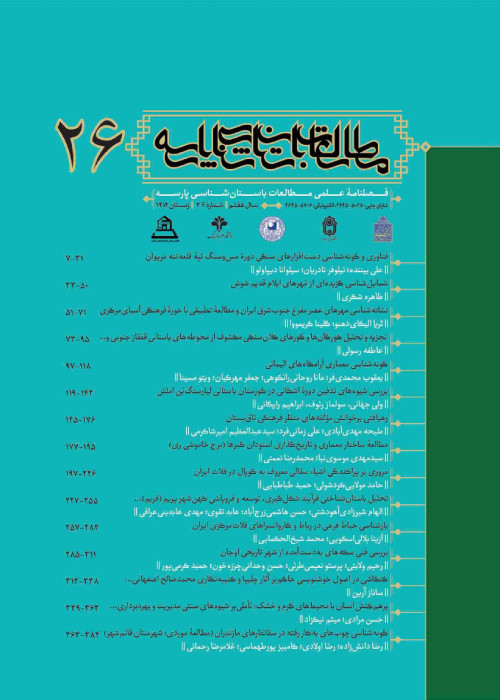The Archaeo-Mineralogy Studying and Comparison of Orange-Red Pottery With Black Core of Elamite Era in Khuzestan, Chahrmahal va Bakhtiyari and Isfahan Provinces
Author(s):
Article Type:
Research/Original Article (دارای رتبه معتبر)
Abstract:
The previous studies on the Elamite pottery generally focused on the form and shape of the artifacts. From the perspective of fabric, very few studies have explored the Elamite pottery. The pottery type studied in this paper is orange (ranging from light brown to red) composed of a tempering material, sand and white particles. The core of this no ornamented, wheel-built pottery is black. In an investigation to outline the scope and boundaries of Haft Tapeh ancient city, a number of the Elamite pottery samples were recovered in certain layers dating back to the late ancient Elam (Sukalmah) and the Middle Elamite near the adobe structures of Haft Tapeh. Haft Tapeh refers to a structure belonging to the Elamite Era located in Khuzestan and south of Susa. One major finding in this city is a tomb from the Middle Elamite Era. Since 1965, this building has been investigated by Negahban and later by Mofidi-Nasr abadi. Thus, Haft Tapeh can undoubtedly be considered a city belonging to the Elamite Era. In this light, the pottery type in this geographical scope can be particularly useful for comparison of similar artifacts found in Isfahan and Chaharmahal and Bakhtiari, both of which could be associated with the Elamite Era. This study focused on Asgaran and Saba as two regions in Isfahan and central part of Ardal in Chaharmahal and Bakhtiari. A total of 10 pottery samples were randomly selected from these regions. They were then compared in terms of fabric and composition against 4 counterparts found in archaeological layers of Haft Tapeh belonging to the Elamite Era. It should be noted that the two-color body in the pottery sample is not at all associated with the type of compounds or curing temperature, Since the two parts are identical in terms of composition. Moreover, it seems that the main reason for the two-color body lies in the curing conditions and techniques (oxidation and reduction) inside the furnace, leading to two different colors. Apart from that, there is a kind of orientation in the components of pottery samples, potentially indicating they were built on wheels.
Keywords:
Elam , Orange-Red Pottery , Petrography , XRD , Ft-IR
Language:
Persian
Published:
Parseh Journal of Archaeological Studies, Volume:3 Issue: 7, 2019
Pages:
23 to 41
magiran.com/p2008540
دانلود و مطالعه متن این مقاله با یکی از روشهای زیر امکان پذیر است:
اشتراک شخصی
با عضویت و پرداخت آنلاین حق اشتراک یکساله به مبلغ 1,390,000ريال میتوانید 70 عنوان مطلب دانلود کنید!
اشتراک سازمانی
به کتابخانه دانشگاه یا محل کار خود پیشنهاد کنید تا اشتراک سازمانی این پایگاه را برای دسترسی نامحدود همه کاربران به متن مطالب تهیه نمایند!
توجه!
- حق عضویت دریافتی صرف حمایت از نشریات عضو و نگهداری، تکمیل و توسعه مگیران میشود.
- پرداخت حق اشتراک و دانلود مقالات اجازه بازنشر آن در سایر رسانههای چاپی و دیجیتال را به کاربر نمیدهد.
In order to view content subscription is required
Personal subscription
Subscribe magiran.com for 70 € euros via PayPal and download 70 articles during a year.
Organization subscription
Please contact us to subscribe your university or library for unlimited access!


